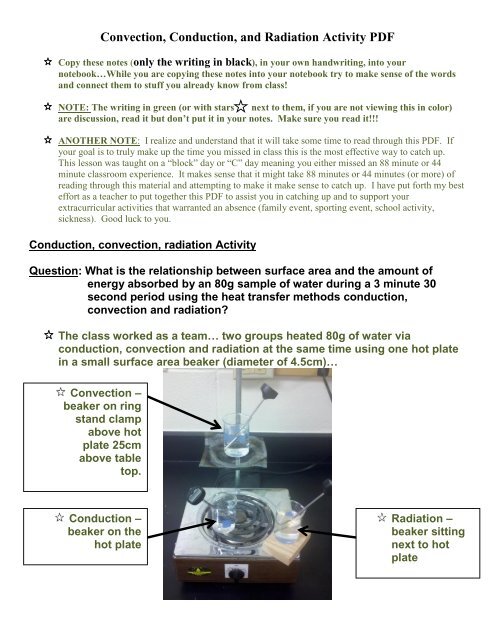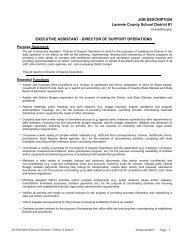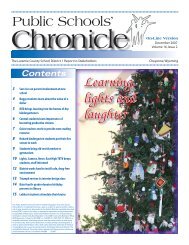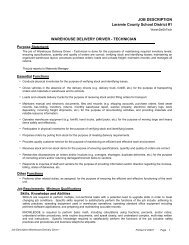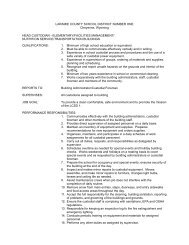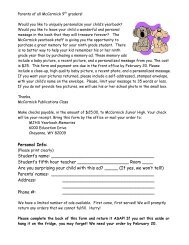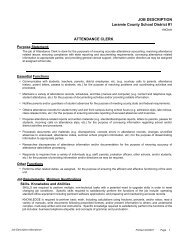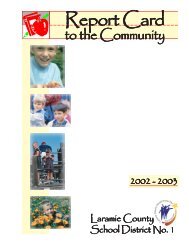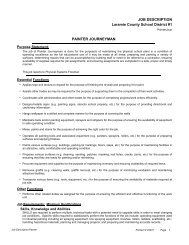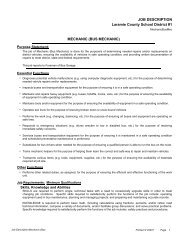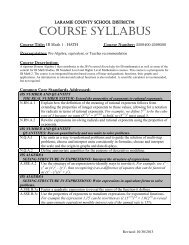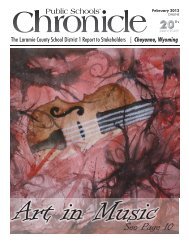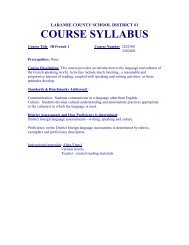Convection, Conduction, and Radiation Activity PDF - Central High ...
Convection, Conduction, and Radiation Activity PDF - Central High ...
Convection, Conduction, and Radiation Activity PDF - Central High ...
You also want an ePaper? Increase the reach of your titles
YUMPU automatically turns print PDFs into web optimized ePapers that Google loves.
<strong>Convection</strong>, <strong>Conduction</strong>, <strong>and</strong> <strong>Radiation</strong> <strong>Activity</strong> <strong>PDF</strong><br />
Copy these notes (only the writing in black), in your own h<strong>and</strong>writing, into your<br />
notebook…While you are copying these notes into your notebook try to make sense of the words<br />
<strong>and</strong> connect them to stuff you already know from class!<br />
NOTE: The writing in green (or with stars next to them, if you are not viewing this in color)<br />
are discussion, read it but don’t put it in your notes. Make sure you read it!!!<br />
ANOTHER NOTE: I realize <strong>and</strong> underst<strong>and</strong> that it will take some time to read through this <strong>PDF</strong>. If<br />
your goal is to truly make up the time you missed in class this is the most effective way to catch up.<br />
This lesson was taught on a “block” day or “C” day meaning you either missed an 88 minute or 44<br />
minute classroom experience. It makes sense that it might take 88 minutes or 44 minutes (or more) of<br />
reading through this material <strong>and</strong> attempting to make it make sense to catch up. I have put forth my best<br />
effort as a teacher to put together this <strong>PDF</strong> to assist you in catching up <strong>and</strong> to support your<br />
extracurricular activities that warranted an absence (family event, sporting event, school activity,<br />
sickness). Good luck to you.<br />
<strong>Conduction</strong>, convection, radiation <strong>Activity</strong><br />
Question: What is the relationship between surface area <strong>and</strong> the amount of<br />
energy absorbed by an 80g sample of water during a 3 minute 30<br />
second period using the heat transfer methods conduction,<br />
convection <strong>and</strong> radiation?<br />
The class worked as a team… two groups heated 80g of water via<br />
conduction, convection <strong>and</strong> radiation at the same time using one hot plate<br />
in a small surface area beaker (diameter of 4.5cm)…<br />
<strong>Convection</strong> –<br />
beaker on ring<br />
st<strong>and</strong> clamp<br />
above hot<br />
plate 25cm<br />
above table<br />
top.<br />
<strong>Conduction</strong> –<br />
beaker on the<br />
hot plate<br />
<strong>Radiation</strong> –<br />
beaker sitting<br />
next to hot<br />
plate
Two other groups will do the same with a medium surface area<br />
beaker(diameter of 7cm)…<br />
<strong>Convection</strong> –<br />
beaker on ring<br />
st<strong>and</strong> clamp<br />
above hot<br />
plate 25cm<br />
above table<br />
top.<br />
<strong>Conduction</strong> –<br />
beaker on the<br />
hot plate<br />
<strong>Radiation</strong> –<br />
beaker sitting<br />
next to hot<br />
plate<br />
Two other groups will do the same with a large surface area<br />
beaker(diameter of 9cm)…<br />
<strong>Convection</strong> –<br />
beaker on ring<br />
st<strong>and</strong> clamp<br />
above hot<br />
plate 25cm<br />
above table<br />
top.<br />
<strong>Conduction</strong> –<br />
beaker on the<br />
hot plate<br />
<strong>Radiation</strong> –<br />
beaker sitting<br />
next to hot<br />
plate
This activity splits up a multi-tiered experiment…each individual<br />
experiment has the following IV <strong>and</strong> DV…<br />
IV: surface area (indicated by the diameter of the beaker)<br />
DV: amount of heat absorbed (indicated by temp change)<br />
Hot plates were turned on to low for 3.5 minutes…<br />
Small sized beakers<br />
(4.5cm diameter)<br />
heating 80g of water<br />
using all 3 heat<br />
transfer methods of<br />
conduction,<br />
convection, <strong>and</strong><br />
radiation.<br />
Medium sized beakers<br />
(7cm diameter)<br />
heating 80g of water<br />
using all 3 heat<br />
transfer methods of<br />
conduction,<br />
convection, <strong>and</strong><br />
radiation.<br />
Large sized beakers<br />
(9cm diameter)<br />
heating 80g of water<br />
using all 3 heat<br />
transfer methods of<br />
conduction,<br />
convection, <strong>and</strong><br />
radiation.
This is the data collected from all the experiments going on in all the different lab<br />
groups. Please copy this information into your notebook…<br />
Graph data:<br />
‣ How many experiments were really going on here?<br />
o 3 different experiments…<br />
• one with <strong>Conduction</strong><br />
IV: surface area<br />
DV: energy absorbed<br />
• one with <strong>Convection</strong><br />
IV: surface area<br />
DV: energy absorbed<br />
• one with <strong>Radiation</strong><br />
IV: surface area<br />
DV: energy absorbed
‣ Can we put the data on the same graph? Yes we can! <br />
o Same IV same DV 3 different lines (one line for conduction,<br />
convection <strong>and</strong> radiation)<br />
o X axis IV Surface area (cm)<br />
o Y axis DV Change in temperature (represented ΔTemp)<br />
Please get your graph set up by labeling the X axis <strong>and</strong> Y axis <strong>and</strong> getting<br />
the numbers labeled… we will graph the data as a class in the next class<br />
period.<br />
Congratulations you have done some work in order to make up the<br />
time you missed in class! Keep up the hard work!<br />
I look forward to seeing you in class!!! <br />
Please come in during AST ASAP <strong>and</strong> ask any clarifying questions you<br />
may have <br />
Note: I realize that the “Academic” in the academic support sign above is spelled incorrectly. This “Acadurmic Support” sign<br />
is on this fusion <strong>PDF</strong> to remind you to come to AST, <strong>and</strong> what better way than with a “catchy” sign? I in no way support the<br />
misspelling of words, but I do support the thoughtful student sentiment expressed when the students responsible for this<br />
sign gave it to me. Thanks Tayton, Ross, <strong>and</strong> Iggy!


